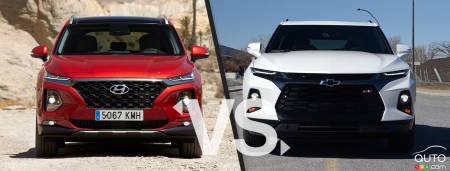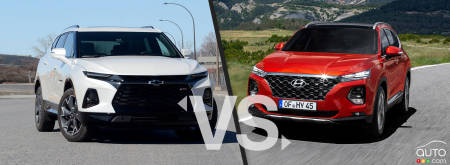Auto123 compares the 2020 Chevrolet Blazer and the 2020 Hyundai Santa Fe.
2019 was an important year for today’s two protagonists. The Blazer resurfaced with a name pulled from the brand’s past, but in a very different form. The Santa Fe, meanwhile, marked the arrival of its 4th generation on the market by becoming a 5-seater model only, leaving the large-format spot in the Korean automaker’s lineup to the new Palisade.
Discover Shopicar! All new makes and models and all current promotions.
2020 Chevrolet Blazer
.jpg?scaledown=450)
Marketing considerations might have compelled Chevrolet to bring back a popular name, but the model bears no resemblance to its ancestor. The new Blazer is based on the same platform as the GMC Acadia and the Cadillac XT5; its styling is both modern and unobtrusive on the base and Premier models. Size-wise, it's slightly larger than the Equinox but smaller than the Traverse. This SUV is a little lower to the ground and a little wider, and the result is a more assertive look.
The RS version is the one that stands out from the crowd, maybe because several elements are actually inspired by the Camaro, especially in the treatment of the front end. RS models also come with a handful of high-gloss black-finish exhaust tips and 21-inch wheels.
Generous on the tech
The interior layout includes a second-row bench seat that slides 13 cm or folds flat to provide up to 1,818 litres of space, which is very practical indeed. As with the Equinox, there's plenty of hard plastic, even in the high-end versions. When it comes to connectivity, an 8-inch colour touchscreen comes standard, as does Apple CarPlay and Android Auto with compatible 4G LTE Wi-Fi technology.
.jpg?scaledown=450)
RS and Premier models can be equipped with adaptive cruise control and a rearview mirror with camera, while a hands-free power tailgate is standard on RS and Premier models. Induction charging is also available. In the sportier RS version, the interior features colour accents in the trim and along the dashboard that add a sporty touch.
The less-flashy Premier version is closer to an Equinox with its leather trim and upholstery and is the only one to offer a fair number of drive-assist systems.
Two engine choices
In the engine bay, the base models house a 2.5L, direct-injection 4-cylinder engine making 193 hp and 188 lb-ft of torque. If you need/want more power, there's a 3.6L V6 that produces 305 hp and 269 lb-ft of torque. The base engine is a little rough and lacks "oomph", to use a scientific term. Our recommendation definitely goes to the V6 that's better suited for this model.
.jpg?scaledown=450)
A start/stop system is standard across the lineup. Both engines are connected to a 9-speed automatic transmission. You also have the choice of a front-wheel drive system in the base models or two different 4WD systems. The simplest of those distributes power in a conventional manner from front to rear. On Premier and RS models, not only do you have dual-clutch all-wheel drive that sends power from front to back, but each axle can distribute power from left to right to the wheel with the most traction.
The RS, by a mile
The experience aboard the 4-cylinder is less than convincing, making the V6 definitely the one to go for. Handling is better with that unit in place, the chassis is solid and the vehicle handles well even on small, winding roads. Steering is precise and predictable without being sporty (except for the RS).
The suspension takes seriously its job of levelling out rough roads, making this a very civilized, urban SUV. But I repeat, to enjoy the ultimate driving experience, you have to go with an RS version. Whether in terms of engine response, handling or all-wheel drive, this is where you enjoy the best Blazer possible. The only drawback is that you'll have to pay around $50,000$ to get all of its goodies.
2020 Hyundai Santa Fe
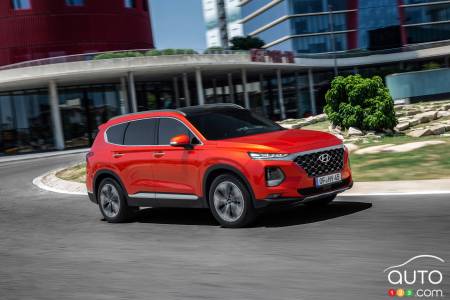
The Santa Fe has undergone several modifications over the generations. However, the objective has remained the same: to offer an affordable and spacious model for the family. For 2020, the Santa Fe comes in several flavours: Essential, Preferred and Preferred Turbo with Sun and Leather, Luxury and Ultimate finishes.
Essential and Preferred use a 2.4L 4-cylinder engine, while the other three get a 2.0L turbo unit. An 8-speed transmission is common to all versions. Essential is the only version available with FWD and optional AWD, which is standard elsewhere.
Loads of equipment for the money
The base model features 17-inch alloy wheels, automatic headlights, LED daytime running lights, fog lights, adjustable and heated side mirrors, heated front seats, 6-way manual driver's seat, 7.0-inch multimedia screen, Apple CarPlay and Android Auto, four USB ports, Bluetooth, leather-wrapped shift lever and steering wheel, air conditioning, cruise control, tilt and telescopic steering wheel and a rear-seat occupant alert.
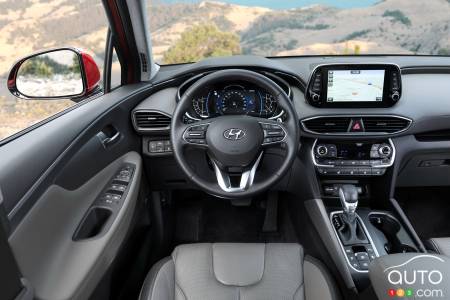
More-advanced drive assist systems arrive in the Preferred model; these include adaptive cruise control, forward collision warning with pedestrian detection and auto brake, lane keeping assist, driver alert, automatic high beams, blind spot monitoring, cross traffic alert, safe exit assist, rear parking sensors and an enhanced rear passenger system with ultrasonic sensors.
The uniquely named Preferred Turbo Sun and Leather version features, yes, a turbo engine, plus leather seats, 8-way power-adjustable driver's seat and leather console cover.
The Luxury Package throws in ventilated front seats with cushion extension, heated rear seats, 360-degree exterior camera, door skid plates, 7.0-inch digital display, power liftgate and blind spot monitor.
Finally, Ultimate Santa Fes get 19-inch wheels, LED headlights, fog lights, rain-sensitive wipers, 8-inch touchscreen with navigation and a 12-speaker Infinity audio system, head-up display, wireless loading and tire-pressure monitoring.
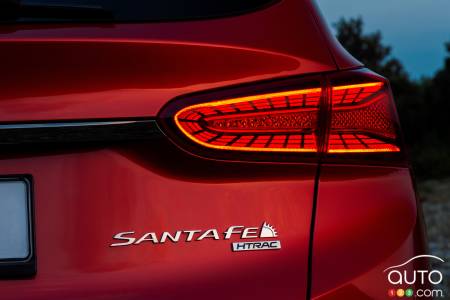
Modern and fun to drive
The 2020 Hyundai Santa Fe has a modern cabin with fit and finish noticeably superior to what you get from the Blazer. Brushed metal accents and rich materials, and comfortable and well-upholstered seats contribute to a great driving experience. Also noteworthy are the ergonomics led by exemplary, easy-to-understand controls, including the quick-response infotainment system.
We liked the ride the SUV delivers, but a little less when it’s fitted with the 2.0-litre turbo engine that offers a lag time when you hit the gas pedal, of the kind that quickly gets on your nerves. The overall ride is also a little firmer than the Blazer, and rocky roads make themselves felt a little more here than in the Chevy. It should be noted, however, that driving is easy and one quickly forgets the utility format behind the wheel.
